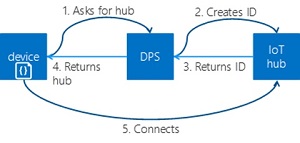News
Microsoft Previews 'IoT Central' Low-Code Service
Microsoft today unveiled a public preview of IoT Central, its Software-as-a-Service (SaaS) offering that works with the company's Azure cloud computing platform to simplify the development of connected device solutions.
IoT Central weds two popular and fast-growing areas of application development: the IoT and the low-code movement, the latter of which has gained credibility among enterprises needing to fulfill a growing demand for business apps in the midst of a chronic shortage of trained developers.
Just as some low-code solutions are designed to "democratize" app development, the new SaaS solution is doing the same for enterprise IoT efforts -- or, as Microsoft put it, "In short, Microsoft IoT Central makes it so that everyone can benefit from IoT."
The low-code functionality lets developers create and persist digital representations of their connected devices, which is done in Microsoft IoT Central Application Builder, used to define device attributes and visualizations by dragging assets from libraries and dropping them into the tool.
"Even before connecting a real device, users can experiment and test their application by simulating a device through the simulation service embedded in Microsoft IoT Central," Microsoft said in a blog post today. "Devices are templatized to make it faster and easier to provision device identities at scale and templates are versioned to support DevOps."
Along with the template-driven, drag-and-drop creation of connected device representations, Microsoft deailed many other mechanisms to simplify the IoT development experience. The company said the SaaS solution frees enterprises from having to hire high-priced talent for IoT initiatives and lessens the burden imposed on users -- typically "business developers" or regular coders who like the convenience of low-code tools -- by taking care of back-end infrastructure concerns.
The company said developers can eliminate hassles associated with creating and deploying IoT solutions, specifically addressing initial setup, management burden and operational overhead. For example, it handles authentication and authorization, provides analytics data and dashboards to represent characteristics of devices and device sets, a rules engine to trigger appropriate actions based on device health or key performance indicators, and more.
 [Click on image for larger view.] The Azure IoT Hub Device Provisioning Service (source: Microsoft).
[Click on image for larger view.] The Azure IoT Hub Device Provisioning Service (source: Microsoft).
For a cloud gateway, the service uses the Azure IoT Hub, used to connect, provision, update and send commands to devices, letting developers leverage features such as:
- Device authentication and secure connectivity: Each device uses its own security key to connect to the cloud in a secure way.
- Extensive set of device libraries: Azure IoT device SDKs are available and supported for a variety of languages and platforms such as Node.js, C/C#, and Java.
- IoT protocols and extensibility: Native support of the MQTT 3.1.1, HTTP 1.1, and AMQP 1.0 protocols for device connectivity.
- Scalability: Microsoft IoT Central automatically scales to support millions of connected devices and by millions of events per second ingested through its cloud gateway, and stored though its time-series storage.
"By reducing the time, skills, and investment required to develop a robust enterprise-grade IoT solution, Microsoft IoT Central also sets you up to quickly reap the powerful business benefits of IoT," the company said in a statement. "You can get started quickly, connecting devices in seconds and moving from concept to production in hours. The complete IoT solution lets you seamlessly scale from a few to millions of connected devices as your IoT needs grow."
The solution, which can be quickly tried out by hooking up a developer board like the MXChip Azure IoT Developer Kit or a Raspberry Pi, is in a public preview following a limited private preview. It's available in a 30-day free trial.
In a separate, related post, Microsoft announced the Device Provisioning Service was now available for the Azure IoT Hub. It lets easily configure zero-touch device provisioning for the Azure IoT Hub, once a laborious, one-step-at-a-time process. "The Device Provisioning Process was designed with the challenges of the supply chain in mind, providing the infrastructure needed to provision millions of devices in a secure and scalable manner," Microsoft said.
About the Author
David Ramel is an editor and writer at Converge 360.